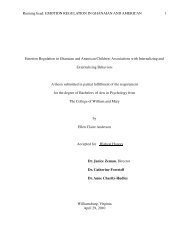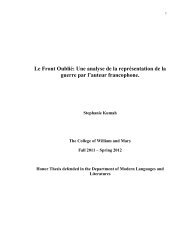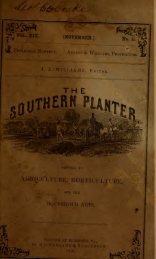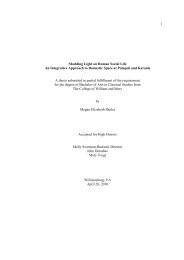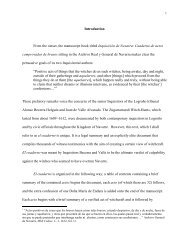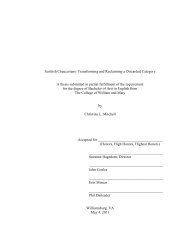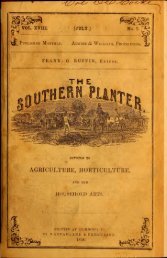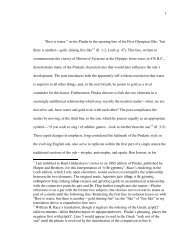Southern planter - The W&M Digital Archive
Southern planter - The W&M Digital Archive
Southern planter - The W&M Digital Archive
Create successful ePaper yourself
Turn your PDF publications into a flip-book with our unique Google optimized e-Paper software.
1859.] THE SOUTHERN PLANTER. 395<br />
offer at this day to the traveller the site of<br />
ruins which attest their past greatness, in<br />
the midst of desolation. Canaan, described<br />
in the Bible as a fertile country, " flowing<br />
with milk and honey," is now nearly deprived<br />
of vegetation, and presents a scene<br />
of almost uninterrupted barrenness. <strong>The</strong><br />
climate of these countries is undoubtedly<br />
modified by the present state of the surface,<br />
and might again be ameliorated by cultiva-<br />
tion, and, were the encroachments of the<br />
sands of the desert stayed, by borders of<br />
vegetation of a proper character. Many,<br />
parts, even of our own country, which now<br />
exhibit a surface of uninterrupted sand,<br />
may be rendered productive, or covered<br />
with trees and herbage.<br />
A series of observations on the progress<br />
of temperature below the surface, in different<br />
parts of the country, and even in different<br />
fields of the same plantation, would be<br />
of value in ascertaining the proper time to<br />
introduce the seed, in order that it might<br />
not be subjected to decay by premature<br />
planting, or lose too much of the necessary<br />
influence of summer, by tardy exposure in<br />
the ground. This may perhaps be most<br />
simply effected, by burying a number of bot-<br />
tles filled with water, at different depths in<br />
the ground, say one at the depth of 6<br />
inches, another at 12, and a third at 18<br />
inches. <strong>The</strong>se, in the course of time, would<br />
take the temperature of the earth in which<br />
they were embedded, and would retain it<br />
sufficiently long unchanged, to admit of its<br />
measurement, by inserting a thermometer<br />
into the mouth of the bottles.<br />
No improvement is more necessary, for<br />
rendering the art of agriculture precise,<br />
than the introduction into its processes of<br />
the two essential principles of science, namely,<br />
those of weight and of measure. All<br />
the processes in our manufactories, on a<br />
great scale, which were formerly conducted<br />
by mere guesses, as to heat and quantities,<br />
are now subjected to rules, in which the<br />
measure of temperature, and the weight of<br />
materials, are definitely ascertained by reli-<br />
able instruments.<br />
<strong>The</strong> foregoing are general views as to the<br />
great principles which govern the peculiari-<br />
ties of climate, and especially that of the<br />
United States, the truth of which, in reference<br />
to our continent, and the modifications<br />
to which they are to be subjected, are to be<br />
settled by observations in the future.<br />
In order, however, that the science of me-<br />
teorology may be founded on reliable data,<br />
and attain that rank which its importance<br />
demands, it is necessary that extended systems<br />
of cooperation should be established.<br />
In regard to climate, no part of the world is<br />
isolated ; that of the smallest island in the<br />
Pacific is governed by the general currents<br />
of the air and the waters of the ocean. To<br />
fully understand, therefore, the causes which<br />
influence the climate of anyone country, or<br />
any one place, it will be necessary to study<br />
the conditions, as to heat, moisture, and the<br />
movements of the air, of all others. It is<br />
evident, also, that, as far as possible, one<br />
method should be adopted, and that instruments<br />
affording the same indications, under<br />
the same conditions, should be employed.<br />
It is true that, for determining the general<br />
changes of temperature, and the great<br />
movements of the atmosphere of the globe,<br />
comparatively few stations of observation, of<br />
the first class, arc required ; but, these should<br />
be properly distributed, well furnished with<br />
instruments, and supplied with a sufficient<br />
corps of observers, to record, at all periods<br />
of the day, the prominent fluctuations. Such<br />
stations, however, can only be established<br />
and supported by the cooperation of a combination<br />
of governments.<br />
A general plan of this kind, for observing<br />
the meteorogical and magnetical changes,<br />
more extensively than had ever before been<br />
projected, was digested by the British Association,<br />
in 1838, in which the principal governments<br />
of Europe were induced to take<br />
an active part ; and had that of the United<br />
States, and those of South America, joined<br />
in the enterprise, a series of watch-towers<br />
of nature would have been distributed over<br />
every part of the earth.<br />
* * * *<br />
<strong>The</strong>se observatories were established to<br />
carry out a series of observations, at the<br />
same moment of absolute time, every two<br />
hours, day and night, (Sunday excepted,)<br />
during three years, together with observa-<br />
tions once every month, continuing 24 hours,<br />
at intervals of five minutes each. * * *<br />
<strong>The</strong> comparisons of these observations are<br />
still in progress, and will occupy the attention<br />
of the student of magnetism and me-<br />
teorology, for many years to come. <strong>The</strong> system<br />
was established more particularly to<br />
study the changes of the magnetic needle,<br />
and on this subject alone, it has afforded information<br />
of sufficient importance to repay<br />
all the labor and time expended on it. It




